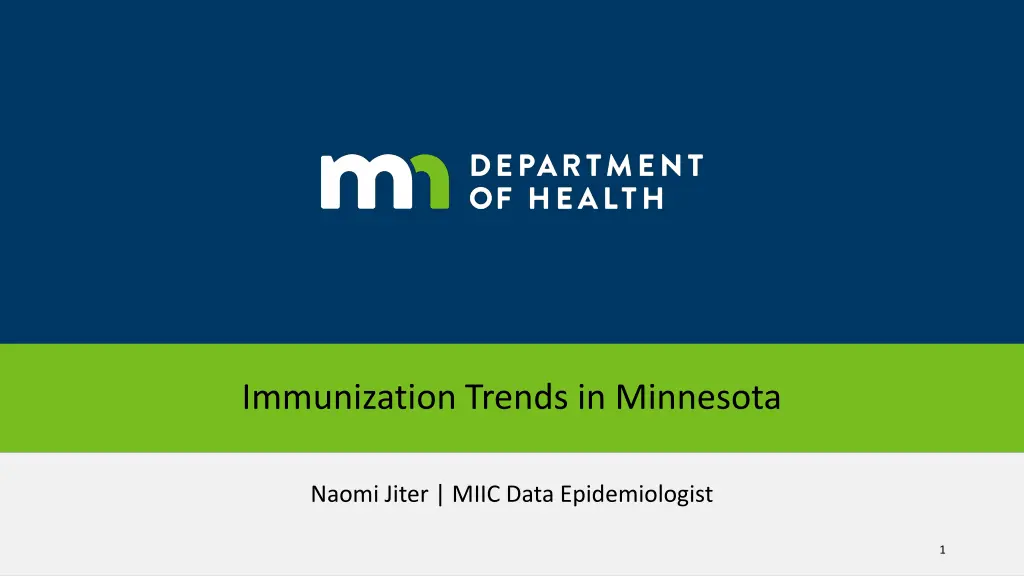
Immunization Trends in Minnesota - Tribal-State Relations and Data Insights
Explore immunization trends in Minnesota, focusing on tribal-state relations and data insights from the Minnesota Immunization Information Connection. Learn about partnerships with Tribal Nations and efforts to address immunization disparities.
Download Presentation

Please find below an Image/Link to download the presentation.
The content on the website is provided AS IS for your information and personal use only. It may not be sold, licensed, or shared on other websites without obtaining consent from the author. If you encounter any issues during the download, it is possible that the publisher has removed the file from their server.
You are allowed to download the files provided on this website for personal or commercial use, subject to the condition that they are used lawfully. All files are the property of their respective owners.
The content on the website is provided AS IS for your information and personal use only. It may not be sold, licensed, or shared on other websites without obtaining consent from the author.
E N D
Presentation Transcript
Immunization Trends in Minnesota Naomi Jiter | MIIC Data Epidemiologist 1
Tribal-State Relations Statement The State of Minnesota is home to 11 federally recognized Indian Tribes with elected Tribal government officials. The State of Minnesota acknowledges and supports the unique political status of Tribal Nations across Minnesota and their absolute right to existence, self-governance, and self-determination. This unique relationship with federally recognized Indian Tribes is cemented by the Constitution of the United States, treaties, statutes, case law, and agreements. The State of Minnesota and Tribal governments across Minnesota significantly benefit from working together, learning from one another, and partnering where possible. The Minnesota Department of Health recognizes, values, and celebrates the vibrant and unique relationships between the 11 Tribal Nations and the State of Minnesota. Partnerships formed through government-to- government relationships with these Tribes will effectively address health disparities and lead to better health outcomes for all of Minnesota. MDH is committed to advancing health equity and eliminating health disparities. In our work, we demonstrate our commitment to Tribal-State relations in the following ways: Providing access to immunization data and records for Tribal Nations and American Indian communities. Building relationships with Tribal Nations and American Indian communities to strengthen efforts to address immunization disparities. 2
About data Data are from the Minnesota Immunization Information Connection (MIIC), Minnesota s statewide immunization information system (IIS). Some of the presented data are available online: Immunizations: Minnesota Public Health Data Access (https://data.web.health.state.mn.us/immunization) Current Childhood and Adolescent Immunization Coverage Rates (www.health.mn.gov/people/immunize/stats/gaps.html) 3
Immunization rates Benchmark Shows us who is up to date on their immunizations by a specific age. Use to measure on-time immunization and look at rates over time. Example: 1+ MMR by 24 months for those born in 2022. Current Show us who is up to date on their immunizations at a specific point in time. Use to identify who still needs to get vaccinated. Example: 1+ MMR as of April 2025 for those born in 2022. 4
Childhood series | Benchmark Childhood immunization rates dropped during COVID-19 pandemic. Remain low but relatively stable with some slight increases. Will focus on a few particular childhood vaccines, based on results of previous analyses and recent outbreaks. 7
Childhood series | Current While around 63% of children born in 2020-2022 received all expected childhood series vaccines by 24 months, their current combined coverage rate is approximately 73%. This shows that more children get vaccinated with time, but current childhood series rates are still lower than necessary for sufficient protection. 8
Adolescent series | Benchmark and current 46% of adolescents born 2009-2011 have received all their adolescent series vaccines. 30% of recent 13-year-old cohorts received all their adolescent vaccines by 13 years of age. 9
1+ MMR by race/ethnicity | Current When looking at total population, both benchmark and current 1+ MMR coverage rates are similar to other childhood vaccines. The immunization gap is found when looking at rates by race/ethnicity. 12
4+ DTaP | Current Of the childhood vaccines, 4+ DTaP has the lowest on-time immunization rate by 24 months (around 70% in recent birth cohorts). Current 4+ DTaP immunization rates for children born in 2020-2022 are higher (at about 79%) than the on- time rates but still comparatively low. 13
DTaP and Tdap | Current 78% of children born 2016- 2018 have completed their DTaP series. 77% of adolescents born 2009-2011 have received at least 1 Tdap dose. 56% of those 18+ have received a Td or Tdap vaccine in the last 10 years. 14
Tdap in pregnancy | Benchmark Tdap immunization coverage rates in pregnant persons have remained stable around 70% in recent years. 15
RSV 16
Infant RSV coverage | Current 51% of infants born during this most recent season were protected from RSV. This rate takes into account infants who received Nirsevimab and birthing parents that received Abyrsvo while pregnant. No comparison to last season due to previous national shortage. 17
RSV in adults 75+ | Current Recently moved to an age-based recommendation. 27% of the current 75+ population in Minnesota have received an RSV vaccine. 18
Summary 19
Moving forward Childhood vaccines dropped during the COVID-19 pandemic and while they have been stable in recent years, they have not reached pre-pandemic coverage. 1+ MMR and 4+ DTaP are two with notable immunization gaps, whose vaccine components also overlap with recent disease outbreaks. Adolescent and adult vaccines have not seen significant changes in recent years but remain low in several areas. All immunization coverage rates therefore have room for improvement in order to reach sufficient levels of protection for the community. 20
Thank you! Naomi Jiter Naomi.Jiter@state.mn.us 21






















